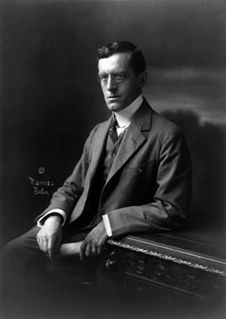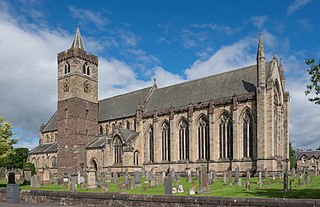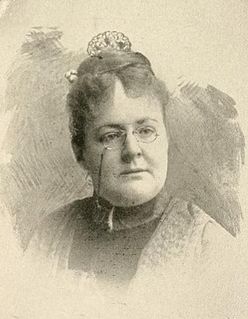
Sir Giles Gilbert Scott was a British architect known for his work on the New Bodleian Library, Cambridge University Library, Lady Margaret Hall, Oxford, Battersea Power Station, Liverpool Cathedral, and designing the iconic red telephone box. Scott came from a family of architects. He was noted for his blending of Gothic tradition with modernism, making what might otherwise have been functionally designed buildings into popular landmarks.

Concord is a town in Middlesex County, Massachusetts, in the United States. At the 2010 census, the town population was 17,668. The United States Census Bureau considers Concord part of Greater Boston. The town center is near where the confluence of the Sudbury and Assabet rivers forms the Concord River.

Daniel Chester French was an American sculptor of the late nineteenth and early twentieth centuries, best known for his design of the monumental statue of Abraham Lincoln (1920) in the Lincoln Memorial in Washington, D.C.

The Cathedral Church of Christ, Blessed Mary the Virgin and St Cuthbert of Durham, commonly known as Durham Cathedral and home of the Shrine of St Cuthbert, is a cathedral in the city of Durham, England. It is the seat of the Bishop of Durham, the fourth-ranked bishop in the Church of England hierarchy.

Ralph Adams Cram was a prolific and influential American architect of collegiate and ecclesiastical buildings, often in the Gothic Revival style. Cram & Ferguson and Cram, Goodhue & Ferguson are partnerships in which he worked. Together with the architect Richard Upjohn and artist John LaFarge, he is honored on December 16 as a feast day in the Episcopal Church of the United States. Cram was a fellow of the American Institute of Architects.

Sleepy Hollow Cemetery is a rural cemetery located on Bedford Street near the center of Concord, Massachusetts. The cemetery is the burial site of a number of famous Concordians, including some of the United States' greatest authors and thinkers, especially on a hill known as "Authors' Ridge."
Charles Zeller Klauder was an American architect best known for his work on university buildings and campus designs, especially his Cathedral of Learning at the University of Pittsburgh, the first educational skyscraper.

Dunblane Cathedral is the larger of the two Church of Scotland parish churches serving Dunblane, near the city of Stirling, in central Scotland.

Daniel Urban Kiley was an American landscape architect, who worked in the style of modern architecture. Kiley designed over one-thousand landscape projects including Gateway Arch National Park in St. Louis.
Philip Hubert Frohman was an architect who is most widely known for his work on the Washington National Cathedral, named, the "Cathedral Church of St. Peter and St. Paul" in Washington, D.C. He worked on the English Gothic style cathedral from 1921 until his death in 1972.

Harriett Lothrop was an American author also known by her pseudonym Margaret Sidney. In addition to writing popular children's stories, she ran her husband Daniel Lothrop's publishing company after his death. After they bought The Wayside country house, they worked hard to make it a center of literary life.

Henry Vaughan was a prolific and talented church architect who emigrated to America from England to bring the English Gothic style to the American branch of the Anglican Communion. He was an apprentice under George Frederick Bodley and went on to great success popularizing the Gothic Revival style.
Hopkins Architects is a prominent British architectural firm established by architects Sir Michael and Patricia, Lady Hopkins.

Francis Edwin Elwell was an American sculptor, teacher and author.

The Concord Free Public Library is a public library in the town of Concord, Massachusetts. The main building is located at 129 Main Street, and the Fowler branch is located at 1322 Main Street in West Concord.

Taylor & Burns Architects is a LEED-accredited architectural firm founded in 1993 and based in Boston, Massachusetts. The firm has two principals, Robert J. Taylor and Carol Burns, and has designed for education, performing arts, worship, and civic communities. They are especially known for their work in creating assembly spaces for large groups.

Edward Fairfax Neild Sr., was an American architect originally from Shreveport, Louisiana, who designed the Harry S. Truman Presidential Library and Museum in Independence, Missouri. He was selected for the task by U.S. President Harry Truman.

John Angel was a British-born sculptor, architectural and ecclesiastical sculptor, medallist and lecturer. He emigrated to the United States where he created architectural sculpture. His work in the United Kingdom and the United States has been critically praised.
John Francis Hennessy (1853–1924) was an Australian architect practicing in New South Wales in the 1880s-1910s, concentrating on projects for the Catholic Church.

The Lexington–Concord Sesquicentennial half dollar, sometimes the Lexington–Concord half dollar or Patriot half dollar, is a commemorative fifty-cent piece struck by the United States Bureau of the Mint in 1925 in honor of the 150th anniversary of the Battles of Lexington and Concord, which began the American Revolutionary War. It was designed by Chester Beach.















